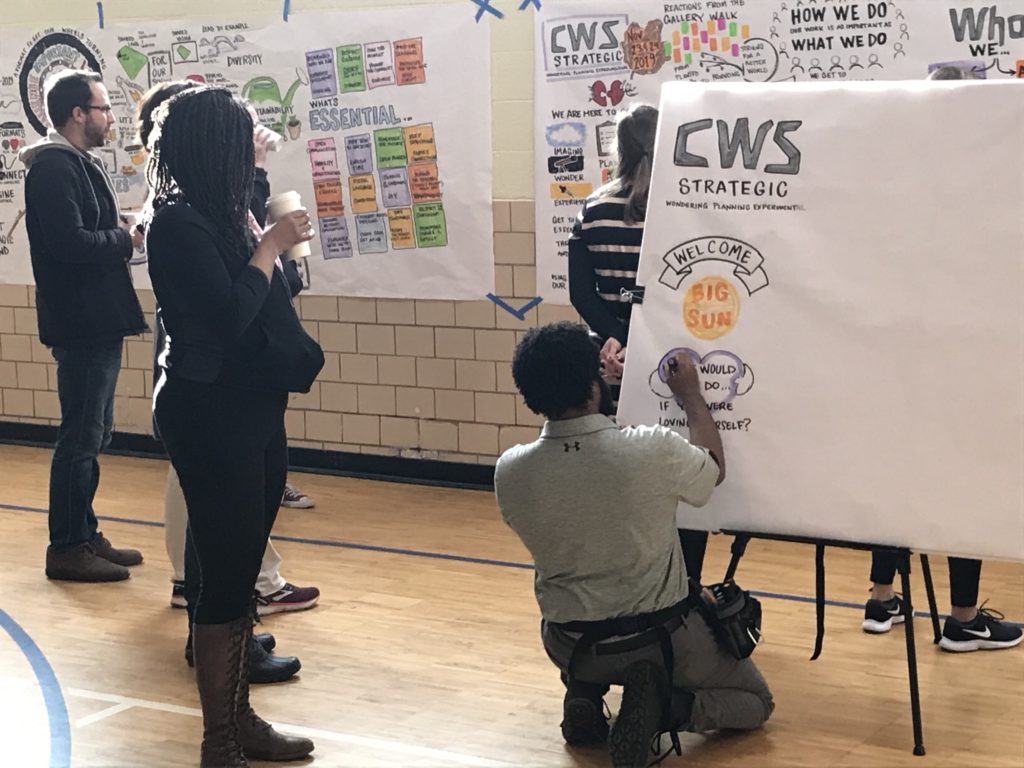Behind methods are always frameworks and world views that amplify impact and purpose. I’ve learned, honed, and applied a few frameworks with colleagues over years that continue to change the way I feel we can approach change. Descriptions of essence are below. Further material is available following the links or utilizing the search function at the top of the page.
- NILO — is a newer integrative framework I’ve created that is guiding so much of what I do with groups these days. It is designed to create inquiry and clarity by exploring the relationship of inner awareness with outer observation, in both the present moment of now and the longer arc of time.
- RiSK — another newer framework I’ve developed (and modified with Quanita Roberson) for daily personal leadership practice. It helps ground the hypothetical and ethereal in the day-to-day. It is a strength-based development practice grounded in kindness with self and other.
- Two Loops — a systems framework grown from early work with Margaret Wheatley and The Berkana Institute. It clarifies how ways of doing things are born, matured, and released. It helps a system to see itself and then to act together in both similarities and differences. Two Loops really helps a group move its mentality from mechanistic thinking to living systems thinking. It also helps a group understand how simple rogue experiments can scale to encompassing systems of influence.
- Asking Powerful Questions — a few insights on living as a community of curiosity. It’s a common saying that “there is nothing as useful as a good question.” There is something very important in developing not just the ability to write questions on a flipchart, but intuiting further when questions are needed for the inner, the outer, the now, or the longer arc of things.
- Hobbit Tools — frankly is one of my favorite frameworks. For those of us that hunger for the simple (the things you can put in a backpack that go with you on epic journeys), this framework is massively helpful for its re-sorting to the essentials. More on Hobbit Tools. Related: Inspired Learning Spaces. Related: Touching The Hearth.
- The Four Fold Practice — four simple markers to guide from the scale of personal leadership to creating communities of practice. This is a primary overarching guide for encountering the body of work that is The Art of Hosting. More on Four Fold Practice.
- Cynefin — a really helpful framing to help become much more complexity-informed and savvy in application. Cynefin grows from the work of Dave Snowden, though my goto person for deep dives is Chris Corrigan. What I love is that this framework helps distinguish and nuance contexts that exist in most situations — the simple, the complicated, the complex, and the chaotic. More on Cynefin.
- SCOPE — is a reframe and alternative to the commonly used SWOT Analysis. In working with a team one day, Quanita Roberson and I noticed some itchiness, particularly in the energy evoked in “threats.” In the moment we created something different that has stuck. Strengths, Challenges, Opportunities, Pitfalls, Evolutionary Action. More on SCOPE.
- The Chaordic Path — a truth telling lens that helps groups reframe their work as an integration or relationship with both chaos and order. Too much chaos paired with too little order is overwhelm. Too much order paired with too little chaos is stagnation. I love creating learning from this model that nuances leadership, management, and innovation. More on The Chaordic Path.
- Chaordic Stepping Stones — is a planning tool that honors The Chaordic Path. It helps bring grounding to map a comprehensive understanding that includes need, purpose, people to be involved, principles and values to guide. It continues with early concepts of supportive design and next steps for projects, valuing both the tangibles and the intangibles. More on Chaordic Stepping Stones.
- Divergence & Convergence — many of us have learned, sometimes painfully, that too many patterns for organizations and teams is a kind of premature convergence. We don’t do, or don’t remember, the valued of oblique and divergent thinking, the not so neat and tidy, to help us get to more enlivened directions together. This framework welcomes more of the strategic messy. More on Divergence & Convergence.
- SIP — is an acronym for a harvesting practice that Quanita Roberson and I created and now use widely. It is a commitment to helping people claim what is simple, impactful, and portable. More on SIP.
- A Simpler Way — The more I work with people, the more I learn that the most likely way to create lasting change is by reclaiming the story that organizations are living systems. It sounds a bit funny even to say that. Lasting change. Perhaps it is the lasting ability to keep changing, keep evolving. Beyond facilitation. Beyond methodologies, important as they are, is the invitation for all of us to reorient ourselves to an adaptive and evolving world. More on A Simpler Way.
- Entanglement, Liberation, and Practice — This is a perspective I’ve put together that names three areas of focus for groups, as well as a background story. It is a response to the question, “What are we really doing and what is really going on here, particularly when groups are doing well together?” It’s a bit of quantum perspective, a bit of invitation for expanded mind, and invitation to be kind with practice. More on ELP.
- Visual Harvesting — it is powerful to bring a graphic recorder to projects. For learning to become visible and artful. For catching what arrises. For giving a bit more tangibility to the social processes of conversational leadership. I have a few folks that I love to bring into teams for this.



